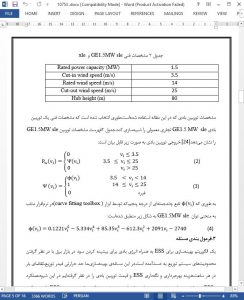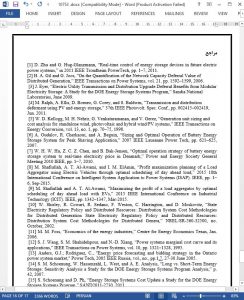Abstract
In distribution systems, load demand can exceed the feeder thermal limit during peak demand periods and cause system damage. This situation can be prevented by load shedding, which results in financial losses to utilities and customers. The problem can be countered by utilizing energy storage systems (ESS) properly. In this paper, we formulate an optimization problem combining the utilization of ESS and wind power in a typical distribution system, whereby real power is optimally scheduled in an electricity market under the constraint that the load demand cannot exceed feeder thermal limit. This approach ensures the reliable operation of the power distribution system and prevents outages. The developed optimization problem is solved for a typical distribution system. The results clearly demonstrate the economical operation of ESS with wind power in distribution systems to prevent outages and maximize the ESS profit.
I. INTRODUCTION
The electricity market has driven the power industry to exploit all possible economic and operational options that ensure the utilization of renewable resources and other options for providing cheap and reliable energy. One of the limitations of renewable sources is the need for energy storage systems (ESS). ESS enhance the predictability of renewable energy sources by smoothing out fluctuations in the difference between the load and generation. Another application of energy storage is to enhance the capacity of distribution feeders and defer the construction of new lines and substations [1]. Feeder deferral has been addressed in many articles, but this problem has not been considered in economic terms [2]– [4]. A cost analysis was performed in which the present value was calculated to determine the economic feasibility of an ESS/PV/wind system. The discount rate, maintenance fees and lifespan effects of ESS on the cost were considered, and the rate of load growth was neglected [5]. Electrical energy time shifting or the energy arbitrage problem of ESS in the energy market have been discussed in many studies [6]– [7] whereas economic analyses of the energy market distribution systems were conducted [8]- [11]. In addition, a procedure for calculating the power system marginal cost curve and its potential applications has been developed [12]. Actual electricity prices have been used to predict future scenarios [13]. ESS market reports have been used to evaluate the market potential for each ESS application and the ESS costs [14]- [15]. In some studies, dynamic programming has been used to achieve optimal ESS charge control [16]– [17].
V. CONCLUSION
The ESS provides a means of deferring feeder upgrades at substantial financial benefits to the grid and system operators. The combined scheduling of the ESS and wind power plant in a constrained distribution feeder is optimized by developing and implementing an algorithm that considers the distribution feeder thermal limit, the electricity price, the load demand, the maximum energy and the power capacity of the ESS, the charging and discharging efficiency of the ESS, and the wind power plant parameters. The developed algorithm is implemented using electricity tariff rates for different customer types and demands from residential, commercial, and industrial customers. The simulation results show that the developed optimal algorithm is economical for combined ESS and wind power scheduling.











